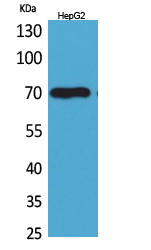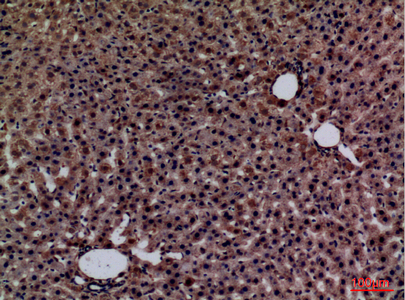产品名称
Glypican-3 Rabbit Polyclonal Antibody
别名
GPC3; OCI5; Glypican-3; GTR2-2; Intestinal protein OCI-5; MXR7
存储缓冲液
Liquid in PBS containing 50% glycerol, 0.5% BSA and 0.02% New type preservative N.
Human Gene Link
http://www.ncbi.nlm.nih.gov/sites/entrez?db=gene&term=2719
Human Swissprot No.
P51654
Human Swissprot Link
http://www.uniprot.org/uniprotkb/P51654/entry
Mouse Gene Link
http://www.ncbi.nlm.nih.gov/sites/entrez?db=gene&term=14734
Mouse Swissprot No.
Q8CFZ4
Mouse Swissprot Link
http://www.uniprot.org/uniprot/Q8CFZ4
Rat Gene Link
http://www.ncbi.nlm.nih.gov/sites/entrez?db=gene&term=25236
Rat Swissprot Link
http://www.uniprot.org/uniprot/P13265
免疫原
The antiserum was produced against synthesized peptide derived from the Internal region of human GPC3. AA range:461-510
特异性
Glypican-3 Polyclonal Antibody detects endogenous levels of Glypican-3 protein.
稀释度
WB 1:500 - 1:2000. IHC-p: 1:100-300 ELISA: 1:20000.. IF 1:50-200
宿主
Polyclonal, Rabbit,IgG
背景介绍
Cell surface heparan sulfate proteoglycans are composed of a membrane-associated protein core substituted with a variable number of heparan sulfate chains. Members of the glypican-related integral membrane proteoglycan family (GRIPS) contain a core protein anchored to the cytoplasmic membrane via a glycosyl phosphatidylinositol linkage. These proteins may play a role in the control of cell division and growth regulation. The protein encoded by this gene can bind to and inhibit the dipeptidyl peptidase activity of CD26, and it can induce apoptosis in certain cell types. Deletion mutations in this gene are associated with Simpson-Golabi-Behmel syndrome, also known as Simpson dysmorphia syndrome. Alternative splicing results in multiple transcript variants. [provided by RefSeq, Sep 2009],
组织表达
Highly expressed in lung, liver and kidney.
细胞定位
Cell membrane ; Lipid-anchor, GPI-anchor ; Extracellular side .
功能
disease:Defects in GPC3 are the cause of Simpson-Golabi-Behmel syndrome (SGBS) [MIM:312870]; also known as Simpson dysmorphia syndrome (SDYS). SGBS is a condition characterized by pre- and postnatal overgrowth (gigantism) with visceral and skeletal anomalies.,function:Cell surface proteoglycan that bears heparan sulfate.,function:Cell surface proteoglycan that bears heparan sulfate. May be involved in the suppression/modulation of growth in the predominantly mesodermal tissues and organs. May play a role in the modulation of IGF2 interactions with its receptor and thereby modulate its function. May regulate growth and tumor predisposition.,similarity:Belongs to the glypican family.,tissue specificity:Highly expressed in lung, liver and kidney.,
纯化
The antibody was affinity-purified from rabbit antiserum by affinity-chromatography using epitope-specific immunogen.



